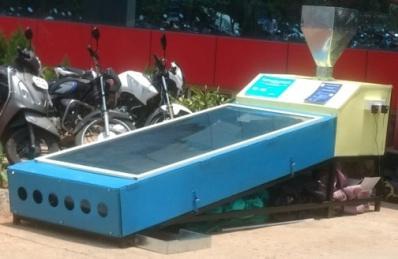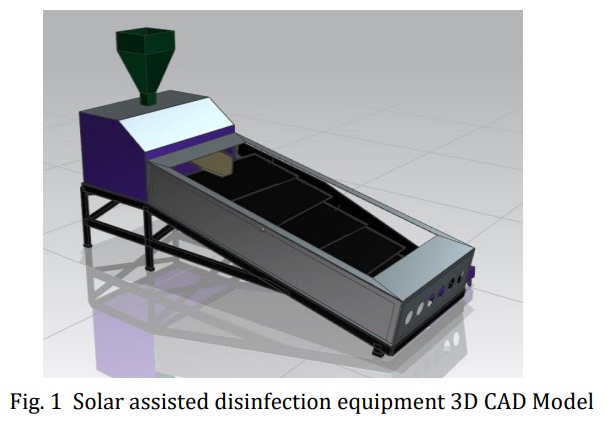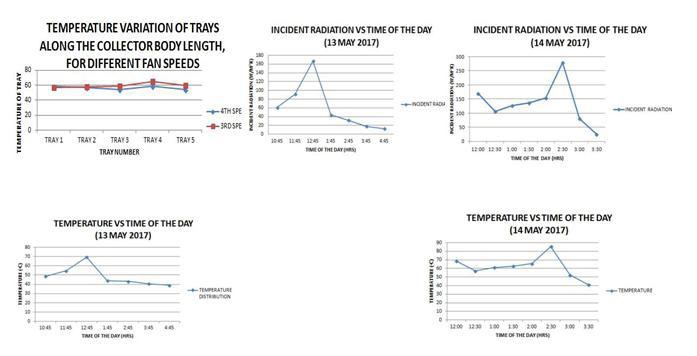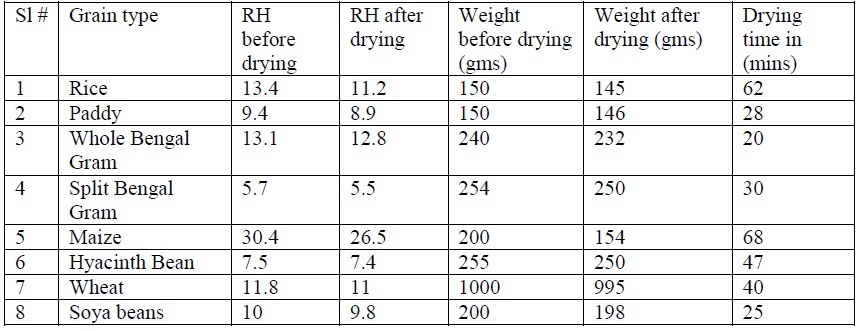





Published on Nov 30, 2023
Food grain disinfestations has an ever growing demand, owing to the damage of food grains that happen during grain handling and storage. In this project, a Solar assisted food grain disinfestations system is proposed, where food grains are dried with a combined effect of direct Solar drying and Hot air drying. This reduces the moisture content of the food grains, to a recommended level for that grain, which aids in storage and preservation of the grains for a longer duration, and avoid spoilage during storage. The system will be designed, developed and fabricated using suitable materials. Food grade materials are to be used where ever necessary. The equipment is expected to dry food grains in a shorter duration, compared to traditional direct solar drying, and also be economical, using very less amount of electricity.
Issues such as rapid urbanization and environmental pollution, and urbanization are causing agricultural land to reduce day by day. The yield is twice or thrice a year but consumption, continuous and is ever increasing. Losses are high in food grains due to insects, rodents and moisture etc during storage. Produce gets spoilt during various stages such as while seeding, growth, harvest and storage. It is found that, about 30% of this spoilage occurs during the storage of the produce. Solar energy, which is abundant in nature, can be economically employed for disinfection of food grains. The main advantage of this system is that the food grains are not treated chemically and are only exposed to sunlight, which heats up air in the machine thus heating and disinfecting the grains. This system will help the farmers, food processing industries and agriculturists in preservation by disinfesting and drying of food grains by removing moisture at low-cost, and is energy efficient. Disinfection or disinfestation is a classical method of food preservation, which provides longer shelf life and lighter weight for transportation and small space for storage. In this method, microbes are killed and moisture content is reduced (which would support the microbial activity), by using means such as heat, ultraviolet rays, or microwaves.
It is found that, about 30% of this spoilage occurs during the storage of the produce. An effort will be made in this project by employing an innovative method for the disinfestation of food grains by using Solar Radiation. Solar energy, which is abundant in nature, can be economically employed for the disinfection of the food grains. The main advantage of this system is that the food grains are not treated chemically; they are only exposed to sunlight, which heats up air, heating and disinfecting the grains. Also the technology is energy efficient. This system will help the farmers and agriculturists in preservation of food grains, by disinfesting and drying them by removing moisture content at a low-cost. It can be scaled up to any required level. This will also help food industries to dry the food grains and other food products at a faster rate by adopting this system
Objectives of this project are as follows:
To attain disinfection by reducing moisture using solar energy, and hence the pathogens present, to obtain optimum results.
To determine optimum exposure time, required temperature and rate of travel of food grains for disinfestation of food grains.
To reduce the equipment cost, and make it affordable to the farmer.
To reduce the time required for disinfecting the grains, and also make it user friendly.
To analyse the results obtained and present the outcome of the experimentation.
Initial literature survey was carried out by referring to different journal papers to understand ideas incorporated by others in the agricultural field of disinfestation. Problem was defined and a detailed model was developed. Design was based solar water heater of 100lpd configuration and detailed drawings were prepared using Unigraphics NX 10.0. Fabrication process involved different materials, according to design specifications. The first to be fabricated were the copper trays (24G). Edges were brazed to avoid leakage, and tray was painted black.

The second material was galvanized iron (24G), used for fabrication of hopper, hopper feeder and grain collector. GI is food grade and economical comparatively. Next was MS sheet metal work (1mm thick). Sheet metal components such as collector body, fan mounting, etc were cut in a CNC plasma cutter, and folded in NC machines. L angles and flats were welded on for strength. Auxiliary fittings were welded on. Frame was fabricated according to the design by using 40*40 MS square pipes. Electrical work for exhaust fans and electronical wiring for vibrator motors were done. The machine was assembled as in design, tested and any issues that arose were sorted out. Trials were done and tabulation of results was done along with analysis. The trials involved different grains, and their temperature, and moisture content, before and after the tests.


The grains to be dried are fed in through the hopper. The flow rate can be controlled by a slider arrangement provided. The grains, at a controlled flow rate, falls onto the feeder tray, and move down by gravity. The grains fall on the copper trays, which are inclined in two directions. The sideways inclinations, follow a zigzag pattern, hence the grains flow along the tray, fall from the provided opening, onto the next tray, and fall off the opening of that tray, which would be cut in the opposite end of the previous tray. The last tray empties the grains onto a grain collector bin, which can be unloaded, once filled. The solar radiation is incident on the tempered glass, which allows the radiation to seep in.
The radiation is trapped inside, due to the Rockwool insulation, reflective covering on the sides, and the glass itself. The building up temperature, heats up the trays, and hence the grains directly. The provided exhaust fans draw in air through the equipment, which also gets heated up. This air heats up the food grains along with direct drying, drying and carrying the moisture content along with it, like in a hot air dryer. The combined effect of direct solar drying, and hot air drying, reduces the moisture content of the food grains, aiding in its preservation.
The High temperature movement of air and lower humidity increases the rate of drying.
Since food is kept in a chamber, it is safe from contamination by rodents, birds, insects, animals and dust.
Higher productivity as the result of higher drying rate.
Drying can be done in the small area.
The dried products can be stored for a longer period of time due to better drying process.
There is no definite control over the temperature attained in the collector..
The food grains may be over heated and may lose their properties.
Less efficient on cloudy days, and operates only in daytime
We see the application of this project widely in the agricultural sector, directly by the farmer who produces it, or by the processing industries.
It can be used in preservation of organic edible produce (food grains), for packaging.
Packed food items, which would range from ready to eat food to ready vegetables and grains, suitably packed for prolonged storage by the consumer, before using it, and is now a thriving industry owing to busy lives of people.
Many Food Processing industries on a very small scale, to very big industries, involving mass production, would also benefit from the machine
It can be seen from experimental data that moisture is removed in a shorter interval of time, compared to the conventional sun drying. It can also be seen that good amount of temperature is obtained on copper trays, even with moderate amount of sunlight. Grain Moisture Meter and IR camera were used for testing. This is also indirectly shown by loss of weight of the grains. Micro organisms are also killed due to the heat. Various parameters are plotted to understand the results graphically.


This project can be further automated to achieve higher accuracy and the outputs can be displayed digitally. More effective mechanism for flow of food grains can be introduced. Cost of the copper trays can be reduced by redesigning the trays, and leakages of air and heat may be further minimized. Temperature can be controlled to an extent, by controlling the amount of sunlight through glass, using a cover. The application may be extended to dry food items other than grains, such as grapes, chilies etc. Heat can be further utilized by storing it in the chamber, by using specialized material beds. An auxiliary heating source can be provided, to be used in absence of sunlight. Solar cells can substitute for electricity used. Further process of removing dead microbes, and cleaning of grains, may be provided with the equipment
The equipment discussed is a cost effective method, which uses minimal amounts of electrical energy. This equipment can be effectively used, even in cloudy conditions. The application of counter flow principle and insulation used makes the equipment more efficient. If the moisture removed is not sufficient, then the flow rate of grains or air can be varied, or multiple passes can be used to obtain the required moisture content. Lack of chemical processes involved, can make the food safer for consumption
[1] Ms. Vaishnavi Bharat Chougule et al, “Design and fabrication of a solar drying system for food preservation”, ijret 11th and 12th march.
[2] Mangesh Gavhale et al, “Design and development of solar seed dryer”, ijiset volume 2 issues 4, april 2015.
[3] Ashish D. Chaudhari, “A review of solar dryer technologies”, international journal of research in advent technology, volume 2 february 2014.
[4] Anupam Tiwari, “A review on solar drying of agricultural produce”, journal of food